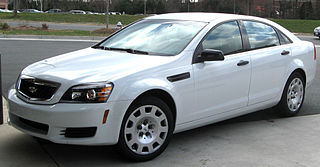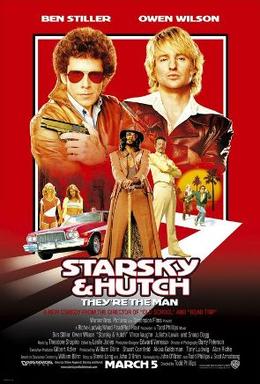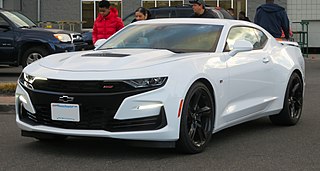'Perfect Car'
When production started on the pilot, Ford Motor Company's studio-TV car loan program was the lease supplier for Spelling-Goldberg Productions that year. Producers looked at lease stock and chose two (one main, one backup) 351 Windsor V8-powered "Bright Red" (code 2B) 2-door Gran Torinos to portray Starsky's automobile.
The cars were equipped with chrome exterior rearview mirrors and protective black vinyl bodyside moldings, and the interiors were black with vinyl bench seats. On top of the factory paint the distinctive white "vector" stripe with bordering black pinstripe was applied. The Torinos had their rear ends lifted by air shocks and were equipped with "U.S." brand 5-slot aluminum wheels with larger rear tires plus a chrome tip on the exhaust pipe.
They also replaced the original 2.75 to 1 rear axle gearing (standard, along with automatic transmission, on 1975 and newer Torinos) with numerically higher gears for better acceleration during stunt driving scenes; this was done during all four seasons to the S-G Torinos. Engine sounds were dubbed into the show soundtrack since the Torinos were mechanically stock; emissions laws forbade modifying the engines or emissions systems of new cars.
When the pilot was successful, Spelling-Goldberg ordered two new 1975 Torinos for the first season. These cars were powered by 400 Modified V8s because extra power was going to be needed for additional stunt driving scenes; from the second to fourth seasons, three 1976 Torinos powered by 460 Lima V8s were used. Due to the success of the series, Ford produced 1,000 "limited edition" replicas of the Starsky and Hutch Torino from March to May 1976 at the Chicago assembly plant. Spelling-Goldberg leased one for a backup vehicle; it was known as "Unit 129". During the series' run, several 1974 to 1976 Gran Torinos were used as stunt cars to minimize damage, wear and tear on the main vehicles.
While Spelling-Goldberg was happy with the Torinos, the stars (specifically Paul Michael Glaser, who played Dave Starsky) were not so pleased. In fact, when Aaron Spelling showed Glaser his character's car, which Spelling had dubbed as the "surprise" that he had outside, Glaser's reaction was more of disgust rather than pleasure. His initial reply was "it's red."
When interviewed about the Torino, which became the de facto "third star", Glaser had no qualms about saying he did not like the car at all. He was quoted as saying "it was huge, it had no pickup, it couldn't handle," and in all of the scenes where he would lock the brakes to stop at a crime scene and bump the car off the curb, Glaser was purposely trying to break the Torino.
Lea Dilallo, a main character in the TV series The Good Doctor , owns a pristine example which has featured prominently in several episodes.

Muscle car is a description according to Merriam-Webster Dictionary that came to use in 1966 for "a group of American-made two-door sports coupes with powerful engines designed for high-performance driving." The Britannica Dictionary describes these as "an American-made two-door sports car with a powerful engine."

The Chevrolet Camaro is a mid-size American automobile manufactured by Chevrolet, classified as a pony car. It first went on sale on September 29, 1966, for the 1967 model year and was designed to compete with the Ford Mustang. The Camaro shared its platform and major components with the Firebird, produced by General Motors' Pontiac division that was also introduced for 1967.

The Ford Torino is an automobile that was produced by Ford for the North American market between 1968 and 1976. It was a competitor in the intermediate market segment. The car was named after the city of Turin, considered "the Italian Detroit". The Torino was initially an upscale variation of the intermediate sized Ford Fairlane with a similar approach to the Ford LTD being the upscale version of the Ford Galaxie. Beginning in the 1968 model year the intermediate Ford line consisted of Fairlane and Torino models. The Fairlane name was utilized for the lower trim level models while the upscale models were called Torino. During this time, the Torino was considered a subseries to the Fairlane. By 1970 Torino had become the primary name for Ford's intermediate, and the Fairlane was now a subseries of the Torino. In 1971 the Fairlane name was dropped altogether, and all Ford intermediates were called Torino. This name was one of several originally proposed for the Mustang while in development. The Torino was essentially a twin to the Mercury Montego line.

The Chevrolet Chevelle is a mid-sized automobile that was produced by Chevrolet in three generations for the 1964 through 1978 model years. Part of the General Motors (GM) A-body platform, the Chevelle was one of Chevrolet's most successful nameplates. Body styles included coupes, sedans, convertibles, and station wagons. The "Super Sport" versions were produced through the 1973 model year and Lagunas from 1973 through to 1976.

The Chevrolet Caprice is a full-sized automobile produced by Chevrolet in North America for the 1965 to 1996 model years. Full-size Chevrolet sales peaked in 1965 with over a million sold. It was the most popular car in the U.S. in the 1960s and early 1970s, which, during its lifetime, included the Biscayne, Bel Air, and Impala.

Starsky & Hutch is an American action television series, which consisted of a 72-minute pilot movie and 92 episodes of 50 minutes each. The show was created by William Blinn, produced by Spelling-Goldberg Productions and starred Paul Michael Glaser and David Soul in the title roles, Starsky and Hutch. It was broadcast from April 1975 to August 1979 on the ABC network.

Starsky & Hutch is a 2004 American buddy cop action comedy film directed by Todd Phillips. The film stars Ben Stiller as David Starsky and Owen Wilson as Ken "Hutch" Hutchinson and is a film adaptation of the original television series of the same name from the 1970s.

Pony car is an American car classification for affordable, compact, highly styled coupés or convertibles with a "sporty" or performance-oriented image. Common characteristics include rear-wheel drive, a long hood, a short decklid, a wide range of options to individualize each car and use of mass-produced parts shared with other models.
Rear-wheel drive (RWD) is a form of engine and transmission layout used in motor vehicles, in which the engine drives the rear wheels only. Until the late 20th century, rear-wheel drive was the most common configuration for cars. Most rear-wheel drive vehicles feature a longitudinally-mounted engine at the front of the car.

George Barris was an American designer and builder of Hollywood custom cars. Barris designed and built the Hirohata Merc. Barris's company, Barris Kustom Industries, designed and built the Munster Koach and DRAG-U-LA for The Munsters; and the 1966 Batmobile for the Batman TV series and film.

The Ford Elite is a personal luxury car produced by Ford and marketed in North American from February 1974 to 1976, using the name Gran Torino Elite for its first model year only then simplified to just Elite for the following two model years.

The Ford LTD II is an automobile produced and marketed by Ford Motor Company between 1977 and 1979 in the United States and Canada. Deriving its name from the full-sized Ford LTD model line, the intermediate LTD II consolidated the Ford Torino and Gran Torino model lines, with the Ford Elite replaced by the Ford Thunderbird. Offered in a two-door sedan, four-door sedan, and station wagon, the LTD II also served as a basis for the final generation of the Ford Ranchero coupe utility.

The Mustang Boss 302 is a high-performance variant of the Ford Mustang originally produced by Ford in 1969 and 1970, alongside its more powerful sibling the Boss 429 Mustang. Ford revived the name for another two year production run in 2012 and 2013. It was produced for the Trans Am racing series.

The fifth-generation Chevrolet Camaro is a pony car that was manufactured by American automobile manufacturer Chevrolet from 2010 to 2015 model years. It is the fifth distinct generation of the muscle/pony car to be produced since its original introduction in 1967. Production of the fifth generation model began on March 16, 2009 after several years on hiatus since the previous generation's production ended in 2002 and went on sale to the public in April 2009 for the 2010 model year.

The second-generation Chevrolet Camaro is an American pony car that was produced by Chevrolet from 1970 through the 1981 model years. It was introduced in the spring of 1970. Build information for model 123-12487 was released to the assembly plants in February of that same year. It was longer, lower, and wider than the first generation Camaro. A convertible, which was available for the first generation, was unavailable for the second. GM engineers have said the second generation is much more of "A Driver's Car" than its predecessor.

The first-generation Chevrolet Camaro is an American muscle car introduced by Chevrolet in the fall of 1966 for the 1967 model year. It rode on a brand-new rear wheel drive GM F-body platform and was available as a 2-door, 2+2 seat, hardtop, and convertible. The F-body was shared with the Pontiac Firebird for all generations. A 230 cu in Chevrolet straight-6 was standard, with several Chevy V8s available as options. The first-generation Camaro was built through the 1969 model year.
The cars in Miami Vice mainly involve the Ferrari Daytona Spyder and the Ferrari Testarossa, but also include other automobiles driven by the characters on the show. Currently one Daytona is in a private collection and the other is on display at the Volo Auto Museum; the Ferrari Testarossa stunt car resides in Kingsport, Tennessee and is owned by Carl Roberts of Carl Roberts Motor Group. Today, one of the hero cars is part of The Witvoet collection owned by Bastiaan Witvoet in Belgium.

Coke bottle styling is an automotive body design with a narrow center surrounded by flaring fenders which bears a general resemblance to a Coca-Cola classic glass contour bottle design. It was introduced by industrial designer Raymond Loewy on the radical 1962 Studebaker Avanti gran turismo.
The London Motor Museum had more than 160 exhibits; they included classic cars from the 1960s, 1970s and 1980s, and a selection of famous cars – including Herbie the Volkswagen Beetle, one of six original Batmobiles used in the first Batman (1989) film, and a Ford Gran Torino from the television series Starsky & Hutch. The museum closed down permanently in June 2018 after a dispute with the local council over business rates. The vehicles have now been moved to other museums across the UK.

The sixth-generation Chevrolet Camaro is an American pony car. Produced by automobile manufacturer Chevrolet, it was first introduced to the public on May 16, 2015. Sales started in 2015 for the 2016 model year. The Camaro now utilizes the GM Alpha platform shared with the Cadillac ATS and CTS and features MacPherson struts in front, rather than the former multi-link setup. General Motors claims that 70 percent of architectural components in the new Camaro are unique to the car.

















